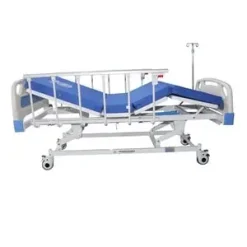Hospital Bed and Mattress
Hospital beds and mattresses play a crucial role in providing comfort and improving patient well-being. Whether used in clinical settings or home care, choosing the right combination enhances recovery and prevents bedsores. This guide will help you understand the key factors when selecting a hospital bed and mattress.
Types of Hospital Beds
Hospital beds meet a variety of medical needs by offering advanced features for both patients and caregivers.
- Manual Hospital Beds: These beds use hand cranks, making them suitable for patients with limited mobility who don’t need frequent adjustments.
- Semi-Electric Hospital Beds: These beds combine manual and electric controls. Caregivers can adjust the head and foot sections electronically, while height adjustments remain manual.
- Fully Electric Hospital Beds: Fully electric beds give patients or caregivers full control of bed height and positioning through a remote. Frequent repositioning becomes more manageable with this option.
Hospital Bed Mattresses
Choosing the right mattress proves just as important as selecting the bed. Different types of hospital bed mattresses offer specific support depending on the patient’s condition.
- Innerspring Mattresses: These basic mattresses provide firm support. However, they may not work well for patients at risk of pressure sores.
- Foam Mattresses: High-density foam in these mattresses distributes weight more evenly, offering better support.
- Air Mattresses: These mattresses prevent bedsores by inflating and deflating in different sections to adjust to the patient’s movements and weight.
Benefits of Hospital Beds and Mattresses
The right hospital bed and mattress bring several benefits to patient care.
- Improved Comfort: Patients adjust positions easily, reducing discomfort and enhancing well-being.
- Better Mobility: Hospital beds assist patients in moving around and getting out of bed with ease.
- Pressure Relief: Mattresses, like foam or air models, prevent bedsores for patients who stay in bed for long periods.
- Enhanced Safety: Safety rails and adjustable heights reduce the risk of falls, keeping patients safer.
- Caregiver Support: Electric beds allow caregivers to make adjustments effortlessly without needing to move the patient manually.
Choosing the Right Hospital Bed and Mattress
When selecting a Healthcare bed with mattress, it’s essential to consider these factors:
- Patient Condition: The patient’s health condition plays a key role in choosing the best option. For instance, air mattresses suit patients at risk of developing bedsores.
- Adjustability: Fully electric beds offer convenience, especially when patients require frequent adjustments.
- Weight Capacity: Ensure the bed and mattress can support the patient’s weight effectively.
- Bed Size: The bed size should match the room, whether it’s for home care or hospital use.
Conclusion
In summary, the right hospital bed and mattress can greatly improve patient care. They provide essential comfort, enhance mobility, and prevent complications such as bedsores. By considering the patient’s specific needs and seeking advice from healthcare professionals, you can make the best choice for optimal care.




